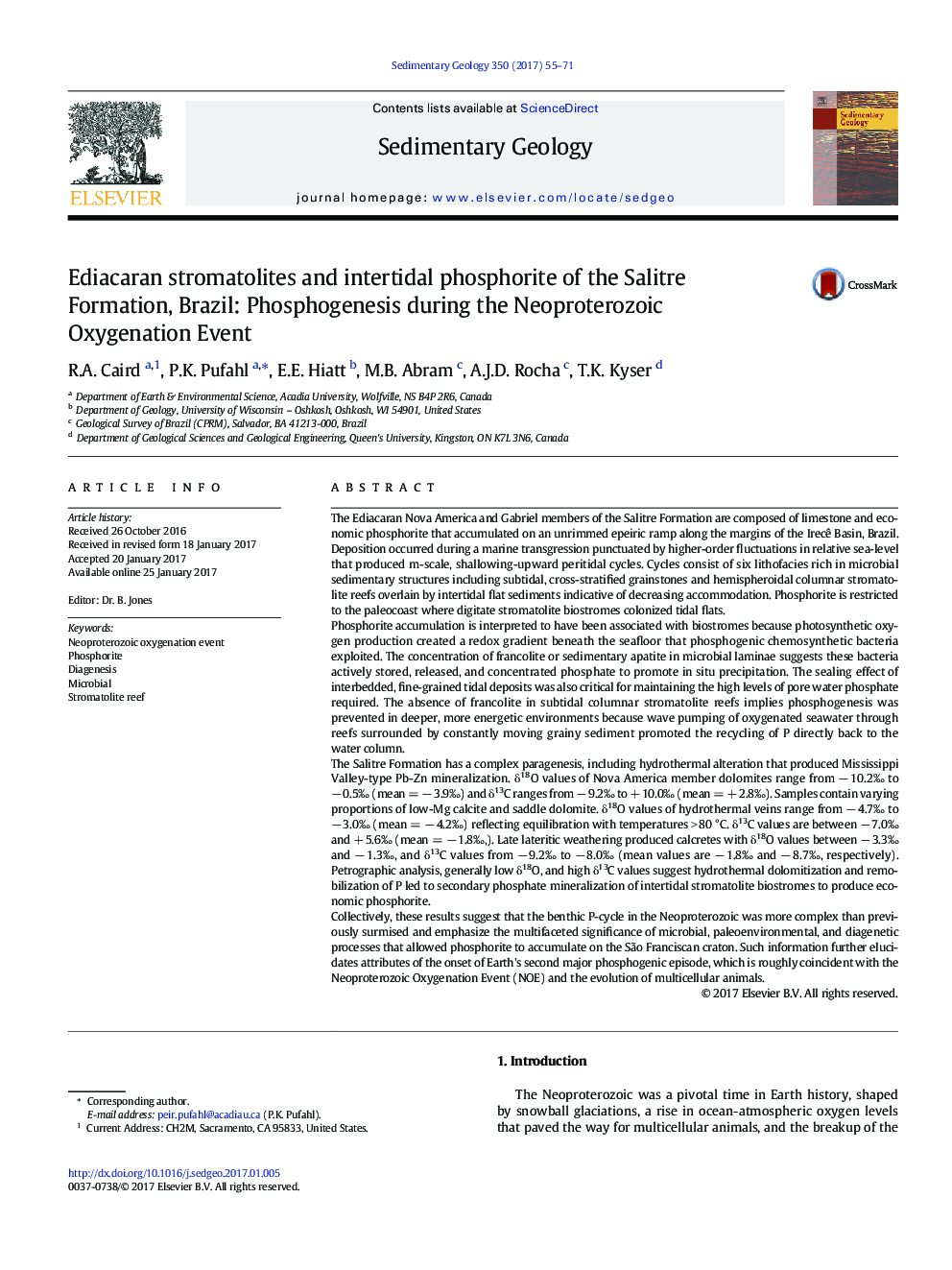| کد مقاله | کد نشریه | سال انتشار | مقاله انگلیسی | نسخه تمام متن |
|---|---|---|---|---|
| 5781316 | 1636013 | 2017 | 17 صفحه PDF | دانلود رایگان |

The Ediacaran Nova America and Gabriel members of the Salitre Formation are composed of limestone and economic phosphorite that accumulated on an unrimmed epeiric ramp along the margins of the Irecê Basin, Brazil. Deposition occurred during a marine transgression punctuated by higher-order fluctuations in relative sea-level that produced m-scale, shallowing-upward peritidal cycles. Cycles consist of six lithofacies rich in microbial sedimentary structures including subtidal, cross-stratified grainstones and hemispheroidal columnar stromatolite reefs overlain by intertidal flat sediments indicative of decreasing accommodation. Phosphorite is restricted to the paleocoast where digitate stromatolite biostromes colonized tidal flats.Phosphorite accumulation is interpreted to have been associated with biostromes because photosynthetic oxygen production created a redox gradient beneath the seafloor that phosphogenic chemosynthetic bacteria exploited. The concentration of francolite or sedimentary apatite in microbial laminae suggests these bacteria actively stored, released, and concentrated phosphate to promote in situ precipitation. The sealing effect of interbedded, fine-grained tidal deposits was also critical for maintaining the high levels of pore water phosphate required. The absence of francolite in subtidal columnar stromatolite reefs implies phosphogenesis was prevented in deeper, more energetic environments because wave pumping of oxygenated seawater through reefs surrounded by constantly moving grainy sediment promoted the recycling of P directly back to the water column.The Salitre Formation has a complex paragenesis, including hydrothermal alteration that produced Mississippi Valley-type Pb-Zn mineralization. δ18O values of Nova America member dolomites range from â 10.2â° to â 0.5â° (mean = â 3.9â°) and δ13C ranges from â 9.2â° to + 10.0â° (mean = + 2.8â°). Samples contain varying proportions of low-Mg calcite and saddle dolomite. δ18O values of hydrothermal veins range from â 4.7â° to â 3.0â° (mean = â 4.2â°) reflecting equilibration with temperatures > 80 °C. δ13C values are between â 7.0â° and + 5.6â° (mean = â 1.8â°,). Late lateritic weathering produced calcretes with δ18O values between â 3.3â° and â 1.3â°, and δ13C values from â 9.2â° to â 8.0â° (mean values are â 1.8â° and â 8.7â°, respectively). Petrographic analysis, generally low δ18O, and high δ13C values suggest hydrothermal dolomitization and remobilization of P led to secondary phosphate mineralization of intertidal stromatolite biostromes to produce economic phosphorite.Collectively, these results suggest that the benthic P-cycle in the Neoproterozoic was more complex than previously surmised and emphasize the multifaceted significance of microbial, paleoenvironmental, and diagenetic processes that allowed phosphorite to accumulate on the São Franciscan craton. Such information further elucidates attributes of the onset of Earth's second major phosphogenic episode, which is roughly coincident with the Neoproterozoic Oxygenation Event (NOE) and the evolution of multicellular animals.
Journal: Sedimentary Geology - Volume 350, 1 April 2017, Pages 55-71